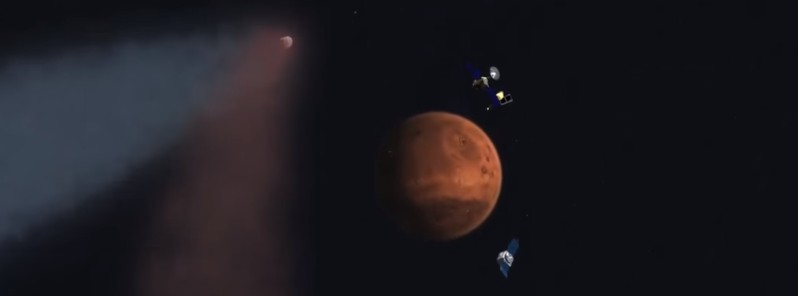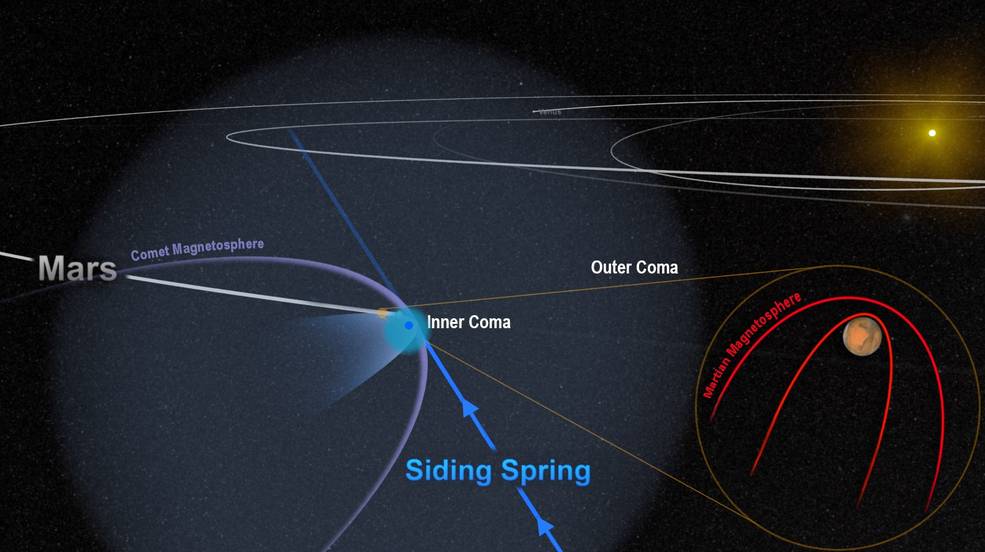Comet Siding Spring plunged the magnetic field around Mars into chaos

When comet C/2013 A1 (Siding Spring) made its historic encounter with planet Mars in October 2014, passing roughly 140 000 km (87 00 miles) from its surface, it wreaked havoc on the magnetic environment around Mars. The effect, temporary but profound, was measured by NASA's Mars Atmosphere and Volatile Evolution (MAVEN).
"Comet Siding Spring plunged the magnetic field around Mars into chaos. We think the encounter blew away part of Mars' upper atmosphere, much like a strong solar storm would," said Jared Espley, a MAVEN science team member at NASA's Goddard.

At very high altitudes Mars' atmosphere is made up of plasma, a layer of electrically charged particles and gas molecules. Charged particles in the solar wind interact with this plasma, and the mingling and moving around of all these charges produces currents. Just like currents in simple electrical circuits, these moving charges induce a magnetic field, which, in Mars' case, is quite weak.
Comet Siding Spring is also surrounded by a magnetic field. This results from the solar wind interacting with the plasma generated in the coma – the envelope of gas flowing from a comet's nucleus as it is heated by the sun.
Comet Siding Spring's nucleus, no more than half a kilometer (about 1/3 mile) in size, is small, but the coma is expansive, stretching out a million kilometers (more than 600 000 miles) in every direction.


The close encounter between comet Siding Spring and Mars flooded the planet with an invisible tide of charged particles from the comet's coma. The dense inner coma reached the surface of the planet, or nearly so. The comet's powerful magnetic field temporarily merged with, and overwhelmed, the planet's weak field, as shown in this artist's depiction. Credit: NASA/Goddard
When comet Siding Spring passed Mars, the comet's coma washed over the planet for several hours, with the dense inner coma reaching, or nearly reaching, the surface. Mars was flooded with an invisible tide of charged particles from the coma, and the powerful magnetic field around the comet temporarily merged with – and overwhelmed – the planet's own weak one.
"The main action took place during the comet's closest approach," said Espley, "but the planet's magnetosphere began to feel some effects as soon as it entered the outer edge of the comet's coma."
At first, the changes were subtle. As Mars' magnetosphere started to react to the comet's approach, some regions began to realign to point in different directions. With the comet's advance, these effects built in intensity, almost making the planet's magnetic field flap like a curtain in the wind. By the time of closest approach – when the plasma from the comet was densest – Mars' magnetic field was in complete chaos. Even hours after the comet's departure, some disruption continued to be measured.
Espley and colleagues think the effects of the plasma tide were similar to those of a strong but short-lived solar storm. And like a solar storm, the comet's close passage likely fueled a temporary surge in the amount of gas escaping from Mars' upper atmosphere. Over time, those storms took their toll on the atmosphere.
Source: NASA/Goddard
Featured image credit: NASA/Goddard

Commenting rules and guidelines
We value the thoughts and opinions of our readers and welcome healthy discussions on our website. In order to maintain a respectful and positive community, we ask that all commenters follow these rules.